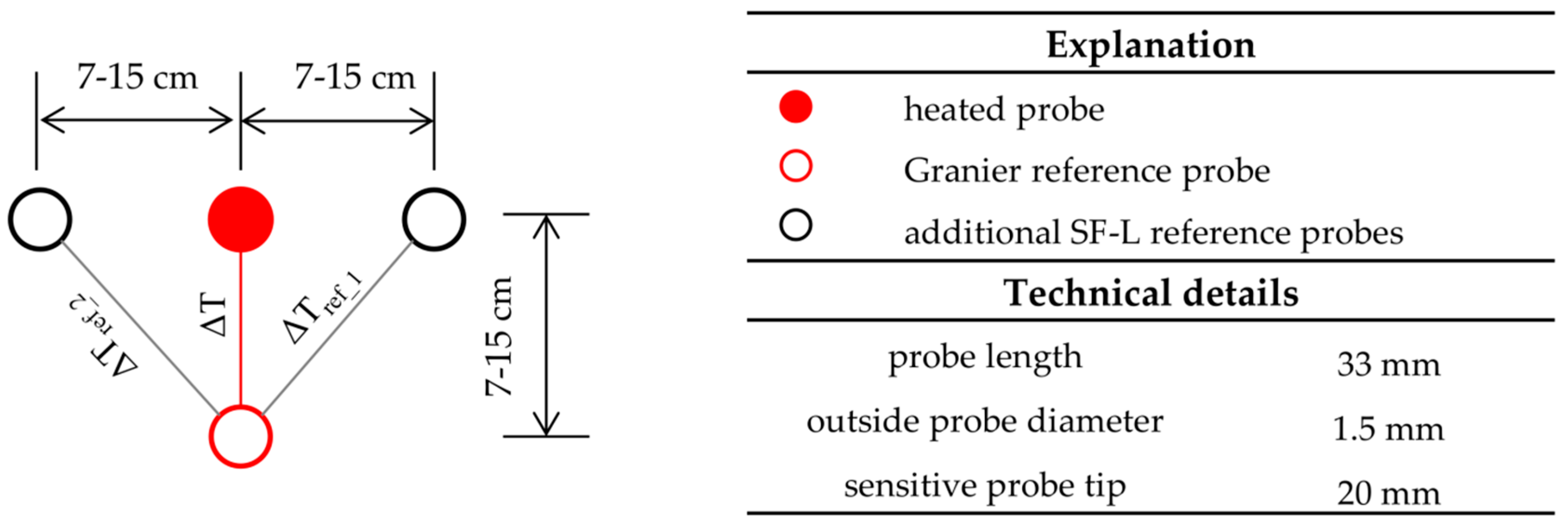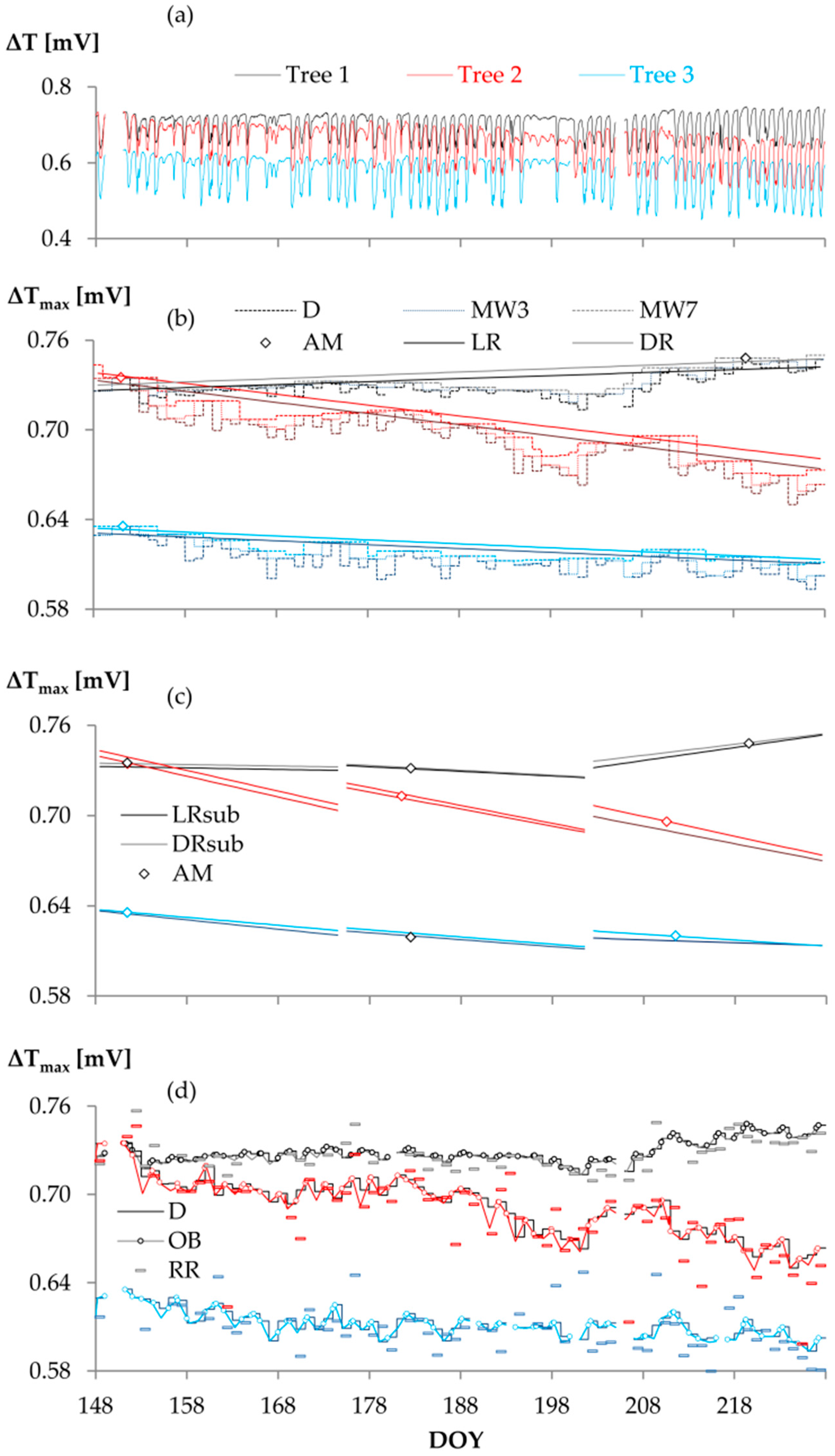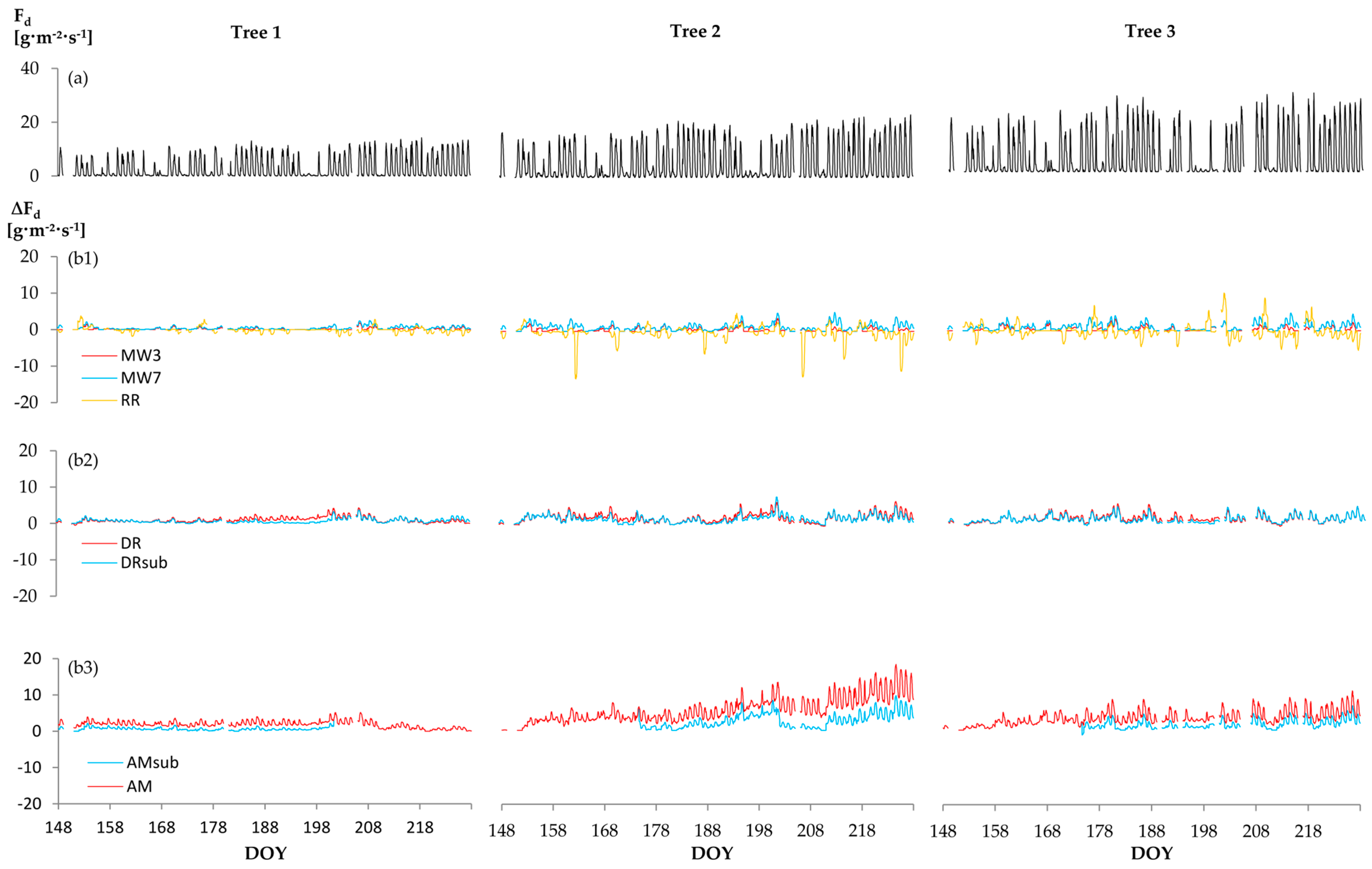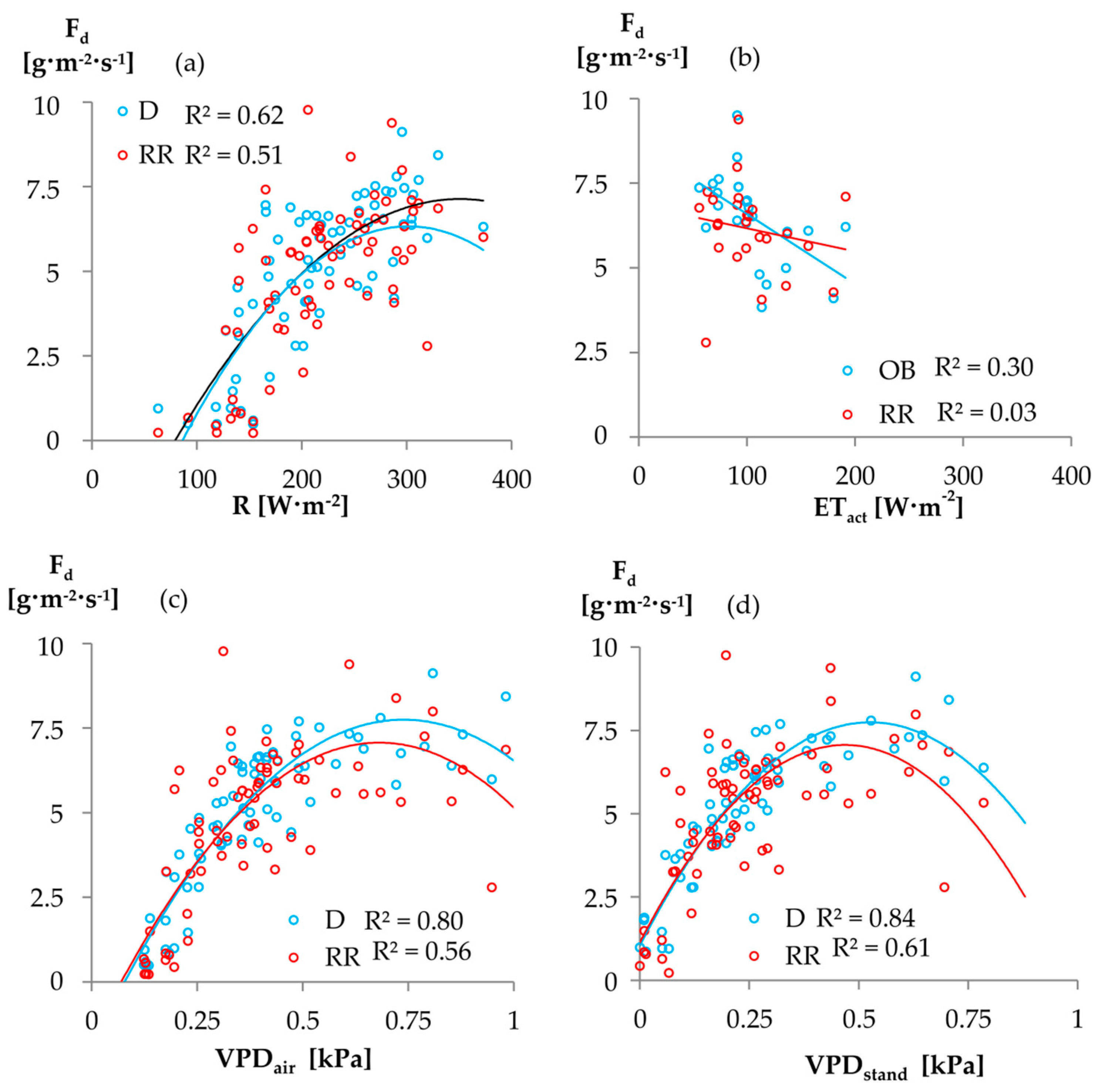Comparing ∆Tmax Determination Approaches for Granier-Based Sapflow Estimations
Abstract
:1. Introduction
2. Materials and Methods
2.1. Study Site
2.2. Sample Trees
2.3. Sapflow Measurements and Calculation
2.4. Environmental Measurements and Classification
3. Results
3.1. Sub-Daily Scale
3.2. Daily Scale
3.3. (Intra-)Seasonal Scale
4. Discussion
4.1. Sub-Daily Scale
4.2. Daily Scale
4.3. (Intra-)Seasonal Scale
5. Conclusions
Acknowledgments
Author Contributions
Conflicts of Interest
References
- Granier, A. Une nouvelle méthode pour la mesure du flux de séve brute dans le tronc des arbres. Ann. Sci. For. 1985, 42, 193–200. [Google Scholar] [CrossRef]
- Lu, P.; Urban, L.; Zhao, P. Granier’s Thermal Dissipation Probe (TDP) Method for Measuring Sap Flow in Trees: Theory and Practice. Acta Bot. Sin. 2004, 46, 631–646. [Google Scholar]
- Wullschleger, S.D.; Meinzer, F.C.; Vertessy, R.A. A review of whole-plant water use studies in trees. Tree Physiol. 1998, 18, 499–512. [Google Scholar] [CrossRef] [PubMed]
- Köstner, B.; Biron, P.; Siegwolf, R.; Granier, A. Estimates of water vapor flux and canopy conductance of Scots pine at the tree level utilizing different xylem sap flow methods. Theor. Appl. Climatol. 1996, 53, 105–113. [Google Scholar] [CrossRef]
- Davis, T.W.; Kuo, C.-M.; Liang, X.; Yu, P.-S. Sap Flow Sensors: Construction, Quality Control and Comparison. Sensors 2012, 12, 954–971. [Google Scholar] [CrossRef] [PubMed]
- Verstraeten, W.W.; Veroustraete, F.; Feyen, J. Assessment of Evapotranspiration and Soil Moisture Content Across Different Scales of Observation. Sensors 2008, 8, 70–117. [Google Scholar] [CrossRef] [PubMed]
- Wilson, K.B.; Hanson, P.J.; Mulholland, P.J.; Baldocchi, D.D.; Wullschleger, S.D. A comparison of methods for determining forest evapotranspiration and its components: Sap-flow, soil water budget, eddy covariance and catchment water balance. Agric. For. Meteorol. 2001, 106, 153–168. [Google Scholar] [CrossRef]
- Ringgaard, R.; Herbst, M.; Friborg, T. Partitioning of forest evapotranspiration: The impact of edge effects and canopy structure. Agric. For. Meteorol. 2012, 166–167, 86–97. [Google Scholar] [CrossRef]
- Kool, D.; Agam, N.; Lazarovitch, N.; Heitman, J.L.; Sauer, T.J.; Ben-Gal, A. A review of approaches for evapotranspiration partitioning. Agric. For. Meteorol. 2014, 184, 56–70. [Google Scholar] [CrossRef]
- Granier, A.; Biron, P.; Breda, N.; Pontailler, J.-Y.; Saugier, B. Transpiration of trees and forest stands: Short and long-term monitoring using sapflow methods. Glob. Chang. Biol. 1996, 2, 265–274. [Google Scholar] [CrossRef]
- Granier, A. Evaluation of transpiration in a Douglas-fir stand by means of sap flow measurements. Tree Physiol. 1987, 3, 309–320. [Google Scholar] [CrossRef] [PubMed]
- Daley, M.J.; Phillips, N.G. Interspecific variation in nighttime transpiration and stomatal conductance in a mixed New England deciduous forest. Tree Physiol. 2006, 26, 411–419. [Google Scholar] [CrossRef] [PubMed]
- Phillips, N.G.; Lewis, J.D.; Logan, B.A.; Tissue, D.T. Inter- and intra-specific variation in nocturnal water transport in Eucalyptus. Tree Physiol. 2010, 30, 586–596. [Google Scholar] [CrossRef] [PubMed]
- Zeppel, M.; Logan, B.; Lewis, J.D.; Phillips, N.; Tissue, D. Why lose water at night? Disentangling the mystery of nocturnal sap flow, transpiration and stomatal conductance—When, where, who? Acta Hortic. 2013, 991, 307–312. [Google Scholar] [CrossRef]
- Reyes-García, C.; Andrade, J.L.; Simá, J.L.; Us-Santamaría, R.; Jackson, P.C. Sapwood to heartwood ratio affects whole-tree water use in dry forest legume and non-legume trees. Trees 2012, 26, 1317–1330. [Google Scholar] [CrossRef]
- Moore, G.W.; Owens, M.K. Transpirational Water Loss in Invaded and Restored Semiarid Riparian Forests. Restor. Ecol. 2011, 20, 1–6. [Google Scholar] [CrossRef]
- Moore, G.W.; Cleverly, J.R.; Owens, M.K. Nocturnal transpiration in riparian Tamarix thickets authenticated by sap flux, eddy covariance and leaf gas exchange measurements. Tree Physiol. 2008, 28, 521–528. [Google Scholar] [CrossRef] [PubMed]
- Köstner, B.; Clausnitzer, F. Transpiration of a spruce and beech stand under soil drought conditions in the Tharandt Forest. Waldökologie Landschaftsforschung Naturschutz 2011, 12, 29–35. [Google Scholar]
- Oliveras, I.; Llorens, P. Medium-term sap flux monitoring in a Scots pine stand: Analysis of the operability of the heat dissipation method for hydrological purposes. Tree Physiol. 2001, 21, 473–480. [Google Scholar] [CrossRef] [PubMed]
- Schwärzel, K.; Feger, K.-H.; Häntzschel, J.; Menzer, A.; Spank, U.; Clausnitzer, F.; Köstner, B.; Bernhofer, C. A novel approach in model-based mapping of soil water conditions at forest sites. For. Ecol. Manag. 2009, 258, 2163–2174. [Google Scholar] [CrossRef]
- Ford, C.R.; Hubbard, R.M.; Kloeppel, B.D.; Vose, J.M. A comparison of sap flux-based evapotranspiration estimates with catchment-scale water balance. Agric. For. Meteorol. 2007, 145, 176–185. [Google Scholar] [CrossRef]
- Regalado, C.M.; Ritter, A. An alternative method to estimate zero flow temperature differences for Granier’s thermal dissipation technique. Tree Physiol. 2007, 27, 1093–1102. [Google Scholar] [CrossRef] [PubMed]
- Oishi, A.C.; Oren, R.; Stoy, P.C. Estimating components of forest evapotranspiration: A footprint approach for scaling sap flux measurements. Agric. For. Meteorol. 2008, 148, 1719–1732. [Google Scholar] [CrossRef]
- Oishi, A.C.; Hawthorne, D.A.; Oren, R. ScienceDirect Baseliner: An open-source, interactive tool for processing sap flux data from thermal dissipation probes. SoftwareX 2016, in press. [Google Scholar] [CrossRef]
- Ward, E.J.; Oren, R.; Sigurdsson, B.D.; Jarvis, P.G.; Linder, S. Fertilization effects on mean stomatal conductance are mediated through changes in the hydraulic attributes of mature Norway spruce trees. Tree Physiol. 2008, 28, 579–596. [Google Scholar] [CrossRef] [PubMed]
- Bogena, H.R.; Bol, R.; Borchard, N.; Brüggemann, N.; Diekkrüger, B.; Drüe, C.; Groh, J.; Gottselig, N.; Huisman, J.A.; Lücke, A.; et al. A terrestrial observatory approach to the integrated investigation of the effects of deforestation on water, energy, and matter fluxes. Sci. China Earth Sci. 2014, 57, 61–75. [Google Scholar] [CrossRef]
- Sciuto, G.; Diekkrüger, B. Influence of Soil Heterogeneity and Spatial Discretization on Catchment Water Balance Modeling. Vadose Zone J. 2010, 9, 955–969. [Google Scholar] [CrossRef]
- Graf, A.; Bogena, H.R.; Drüe, C.; Hardelauf, H.; Pütz, T.; Heinemann, G.; Vereecken, H. Spatiotemporal relations between water budget components and soil water content in a forested tributary catchment. Am. Geophys. Union 2014, 50, 4837–4857. [Google Scholar] [CrossRef]
- Etmann, M. Dendrologische Aufnahmen im Wassereinzugsgebiet Oberer Wüstebach anhand verschiedener Mess-und Schätzverfahren. Ph.D. Thesis, Westfälische Wilhelms-Universität Münster, Münster, Germany, 2009. [Google Scholar]
- Jackson, L.W.R. Radial Growth of Forest Trees in the Georgia Piedmont. Ecology 1952, 33, 336–341. [Google Scholar] [CrossRef]
- User Manual for SF-L Sensor-Patent Pending; Version 1.3; Ecomatik Umweltmess-und Datentechnik: Dachau, Germany, 2005.
- Drüe, C.; Ney, P.; Heinemann, G. Observation of atmosphere-forest exchange processes at the TERENO site Wüstebach. In Proceedings of the the AGU Conference, San Francisco, CA, USA, 3–7 December 2012; Available online: http://fallmeeting.agu.org/2012/files/2012/11/Druee_Wuestebach_Poster3.pdf (accessed on 14 January 2016).
- Lundblad, M.; Lagergen, F.; Lindroth, A. Evaluation of heat balance and heat dissipation methods for sapflow measurements in pine and spruce. Ann. For. Sci. 2001, 58, 625–638. [Google Scholar] [CrossRef]
- Čermák, J.; Deml, M.; Penka, J.M. A new method of sap flow rate determination in trees. Biol. Plant. 1973, 15, 171–178. [Google Scholar] [CrossRef]
- Ringgaard, R.; Herbst, M.; Friborg, T. Partitioning forest evapotranspiration: Interception evaporation and the impact of canopy structure, local and regional advection. J. Hydrol. 2014, 517, 677–690. [Google Scholar] [CrossRef]
- Papale, D.; Reichstein, M.; Aubinet, M.; Canfora, E.; Bernhofer, C.; Kutsch, W.; Longdoz, B.; Rambal, S.; Valentini, R.; Vesala, T.; et al. Towards a standardized processing of Net Ecosystem Exchange measured with eddy covariance technique: Algorithms and uncertainty estimation. Biogeosciences 2006, 3, 571–583. [Google Scholar] [CrossRef]
- Köstner, B. Evaporation and transpiration from forests in Central Europe—Relevance of patch-level studies for spatial scaling. Meteorol. Atmos. Phys. 2001, 76, 69–82. [Google Scholar] [CrossRef]
- Tatarinov, F.A.; Kučera, J.; Cienciala, E. The analysis of physical background of tree sap flow measurement based on thermal methods. Meas. Sci. Technol. 2005, 16, 1157–1169. [Google Scholar] [CrossRef]







| Tree | DBH (cm) | SWD (cm) | CA (m2) | Main Growing Period | |
|---|---|---|---|---|---|
| Start | End | ||||
| 1 | 58.4 | 6.1 | 52.3 | 6 May | 25 August |
| 2 | 54.3 | 5.7 | 50.1 | 24 May | 25 August |
| 3 | 51.7 | 5.4 | 61.9 | 15 May | 14 August |
| Means | 54.8 | 5.7 | 54.8 | 25 May | 14 August |
| ∆Tmax Approach | ID | ∆Tmax Determination | References | Implementation in This Study |
|---|---|---|---|---|
| Systematic approaches | ||||
| Daily maximum | D | Daily maximum | [1] | Daily ∆Tmax determination |
| Moving window | MW | Dynamic determination based on dynamic time windows of 3 (MW3) to 14 days (MW14) | [2,8,15,21] | Dynamic time windows of 3, 5, 7, 9 days, always starting 1, 2, 3, 4 days before the actual date of study |
| Linear regression | LR | First calculate local maxima of moving 10 day periods, then calculate new ∆Tmax by LR of the local maxima and DOY | [2,11] | LR based on local maxima of 9 day period |
| Double regression | DR | Elimination of local ∆Tmax below the LR line and new LR based on remaining data points | [2] | Regression and data point selection based on local maxima of 9 day period |
| Absolute maximum | AM | Absolute maximum within selected study period | Absolute maximum within selected study period | |
| Physically-based approaches | ||||
| Oishi baseliner | OB | Identification of points in time where flow is likely zero, based on ∆T stability and biophysical conditions; baseline is set by interpolation between selected points; measured ∆T values that exceed the interpolation line are integrated into the baseline | [23,24] | Model setup for point selection: vapour pressure deficit threshold = 0.05 kPa; global radiation threshold for night-time definition = 5.0 W·m−2 |
| Simulated ∆Tmax | RR | Daily simulation of ∆Tmax based on the relationship between potential evapotranspiration and sapflow readings | [22] | Model setup: transformed potential evapotranspiration limit (ETp*) limit night-time definition = 0.1; proportionality tolerance = 0.1; exclusion of days with coefficients of determination between selected ETp* and sapflow readings < 0.75 |
| ∆Tmax Approach | % Deviation from D | |
|---|---|---|
| Dry Days, High Radiation | Wet Days, Low Radiation | |
| OB | 0 | −10 |
| RR | −13 | 3 |
| MW3 | 7 | 25 |
| MW5 | 12 | 36 |
| MW7 | 17 | 45 |
| MW9 | 20 | 53 |
| LR | 17 | 64 |
| DR | 24 | 95 |
| AM | 57 | 202 |
© 2016 by the authors; licensee MDPI, Basel, Switzerland. This article is an open access article distributed under the terms and conditions of the Creative Commons Attribution (CC-BY) license (http://creativecommons.org/licenses/by/4.0/).
Share and Cite
Rabbel, I.; Diekkrüger, B.; Voigt, H.; Neuwirth, B. Comparing ∆Tmax Determination Approaches for Granier-Based Sapflow Estimations. Sensors 2016, 16, 2042. https://doi.org/10.3390/s16122042
Rabbel I, Diekkrüger B, Voigt H, Neuwirth B. Comparing ∆Tmax Determination Approaches for Granier-Based Sapflow Estimations. Sensors. 2016; 16(12):2042. https://doi.org/10.3390/s16122042
Chicago/Turabian StyleRabbel, Inken, Bernd Diekkrüger, Holm Voigt, and Burkhard Neuwirth. 2016. "Comparing ∆Tmax Determination Approaches for Granier-Based Sapflow Estimations" Sensors 16, no. 12: 2042. https://doi.org/10.3390/s16122042






